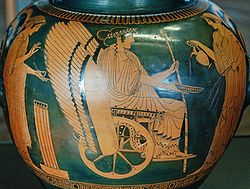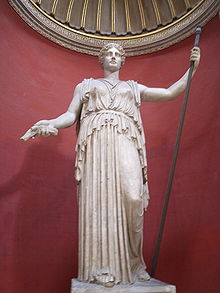- Demeter
-
For other meanings, see Demeter (disambiguation).
Demeter 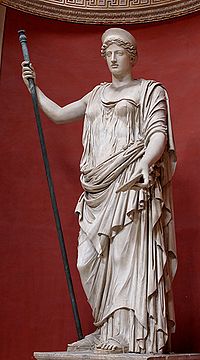
Goddess of the Earth, Agriculture, Harvest, and Forests Abode Mount Olympus Symbol Torch, Lion, Cornucopia, Sheaves of Wheat Parents Cronus and Rhea Siblings Poseidon, Hades, Hera, Hestia, Zeus. Chiron Children Persephone, Arion Roman equivalent Ceres In Greek mythology, Demeter (/diˈmiːtər/; Attic Δημήτηρ Dēmētēr. Doric Δαμάτηρ Dāmātēr) is the goddess of the harvest, who presided over grains, the fertility of the earth, and the seasons (personified by the Hours). Her common surnames are Sito (σίτος: wheat) as the giver of food or corn/grain[1] and Thesmophoros (θεσμός, thesmos: divine order, unwritten law) as a mark of the civilized existence of agricultural society.[2] Though Demeter is often described simply as the goddess of the harvest, she presided also over the sanctity of marriage, the sacred law, and the cycle of life and death. She and her daughter Persephone were the central figures of the Eleusinian Mysteries that predated the Olympian pantheon. In the Linear B Mycenean Greek tablets of circa 1400-1200 BC found at Pylos, the "two mistresses and the king" are identified with Demeter, Persephone and Poseidon.[3] Her Roman equivalent is Ceres.
Contents
Etymology
The earliest attested form of Demeter's name is Da-ma-te, written in Linear B (Mycenean Greek). Her character as mother-goddess is identified in the second element of her name meter (μήτηρ) derived from PIE "mater" (mother).[4] In antiquity, different explanations were already proffered for the first element of her name. It is possible that Da (Δα) (which became Attic De (Δη)), is the Doric form of Ge (γή); the old name of the chthonic earth-goddess and Demeter is "Mother-Earth".[5] This root also appears in the Linear B inscription E-ne-si-da-o-ne, "earth-shaker", as an aspect of the god Poseidon.[6] However, the dā element is not so simply equated with "earth" according to John Chadwick:[7]
The element De may be connected with Deo, a surname of Demeter[8] probably derived from the Cretan word deai (δηαί), Ionic zeai (ζηαί) meaning "barley", so that she is the Corn-Mother and the giver of food generally.[9] Arcadian cult to Demeter links her to a male deity (Greek: Paredros), who accompanied the Great Goddess and has been interpreted as a possible substitution for Poseidon; Demeter may therefore be related to a Minoan Great Goddess.[10]
An alternative, protoeuropean etymology comes through Potnia and Despoina; where "De" is a derivative of PIE "dem" (house, dome), and Demeter is "mother of the house" (from PIE *dems-mater).[11]
Greek mythology
Demeter drives her horse-drawn chariot containing her daughter Persephone-Kore at Selinunte, Sicily 6th century BC
In some of the earliest accounts Demeter was triune goddess representing the Virgin (Kore), the Mother (Pluto "Abundance"), and the Crone ('Persephone the Destroyer'), representing the cycle of birth, life, and death. In later legends, the name Pluto was transferred to the god of the underworld, and elements of Kore and the name Persephone became associated as her daughter.[12]
Another aspect of Demeter, was known as the Aganippe "the Mare who destroys mercifully", a black winged horse worshiped by certain cults. In this aspect her idols (such as one found in Mavrospelya, the Black Cave, in Phigalia) she was portrayed as mare-headed with a mane entwined with Gorgon Snakes.[13] This aspect was also associated with Anion (or Arion) whom Heracles rode, who later inspired tales of Pegasus.[14] Aganippe became associated with a spring, where Pegasus was born according to one legend, and the nymph of the same name.
Demeter as an agricultural goddess appears rarely in the epic poetry. In Homer's Odyssey she is the blond-haired goddess who is separating the chaff from the grain.[15] The harvesters must pray to Zeus-Chthonios (chthonic Zeus) and Demeter so that the crop will be full and strong.[16] In the Theogony of Hesiod she is the daughter of Cronus and Rhea. At the marriage of Cadmus and Harmonia, Demeter lured Iasion away from the other revelers. They proceeded to have intercourse in a ploughed furrow in Crete; she later gave him a son, Ploutos.[17]
Persephone, Queen of the underworld, is daughter of Zeus and Demeter.[18] The myth of the rape of Persephone seems to be pre-Greek. In the Greek version Ploutos (πλούτος, wealth) represents the wealth of the corn that was stored in underground silos or ceramic jars (pithoi). Similar subterranean pithoi were used in ancient times for funerary practices and Pluto is fused with Hades, the King of the underworld. During summer months the Greek Corn-Maiden (Kore) is lying in the corn of the underground silos, abducted by Hades (Pluto) as it is described in Theogony. Kore is fused with Persephone, the Queen of the underworld. At the beginning of the autumn, when the corn of the old crop is laid on the fields she ascends and is reunited with her mother Demeter, for at this time the old crop and the new meet each other.[19]
In the myths of isolated Arcadia in southern Greece Despoina (Persephone), is daughter of Demeter and Poseidon Hippios, Horse-Poseidon. These myths seem to be connected with the first Greek-speaking people who came from the north during the Bronze age. Poseidon represents the river spirit of the underworld and he appears as a horse as it often happens in northern-European folklore. He pursues the mare-Demeter and she bears one daughter who obviously originally had the form or the shape of a mare too. Demeter and Despoina were closely connected with the springs and the animals. They were related with the God of the waters Poseidon and especially with the mistress of the animals Artemis who was the first nymph.[20]
In another tale, Demeter punished Erysichthon of Thessaly by inflicting him with insatiable hunger after he cut down a tree in a sacred garden which killed a dryad and the other dryads informed Demeter of this.
Corn mother at Eleusis
Main article: Eleusinian MysteriesAccording to the Athenian rhetorician Isocrates, the greatest gifts which Demeter gave were cereal (also known as corn in modern Britain), the cultivation of which made man different from wild animals and the Mysteries which give the initiate higher hopes in this life and the afterlife.[21]
In the Homeric Hymn to Demeter, dated to about the seventh century BC,[22] she is invoked as the "bringer of seasons", a subtle sign that she was worshipped long before she was made one of the Olympians. She and her daughter Persephone were the central figures of the Eleusinian Mysteries that also predated the Olympian pantheon.
Demeter's emblem is the poppy, a bright red flower that grows among the barley.[23]
Titles and functions
Demeter's epithets show her many religious functions. She was the "Corn-Mother" who blesses the harvesters. Some cults interpreted her as "Mother-Earth". Demeter may be linked to goddess-cults of Minoan Crete, and embody aspects of a pre-Hellenic Great Goddess. Her other epithets include:
- Aganippe ("the Mare who destroys mercifully", "Night-Mare")
- The Crone, Persephone the Destroyer. Representing her role as bringer of death. The name was later transferred to her daughter.
- The Virgin, Kore. Representing her role as bringer of life. The name was later associated with her daughter Persephone.
- Potnia ("mistress") in the Homeric Hymn to Demeter. Hera especially, but also Artemis and Athena, are addressed as "potnia" as well.
- The Mother, Pluto ("Abundance") representing her role as long life and harvest. The name was later transferred onto a separate god of the underworld, who married her daughter Persephone.
- Despoina ("mistress of the house"), a Greek word similar to the Mycenean potnia. This title was also applied to Persephone, Aphrodite and Hecate.
- Thesmophoros ("giver of customs" or even "legislator"), a role that links her to the even more ancient goddess Themis,[2] derived from thesmos, the unwritten law.[24] This title was connected with the Thesmophoria, a festival of secret women-only rituals in Athens connected with marriage customs.
- Erinys ("implacable"),[25] with a function similar with the function of the avenging Dike (Justice), goddess of moral justice based on custom rules who represents the divine retribution,[26] and the Erinyes, female ancient chthonic deities of vengeance and implacable agents of retribution.
- Chloe ("the green shoot"),[27] that invokes her powers of ever-returning fertility, as does Chthonia.
- Anesidora ("sending up gifts from the earth") applied to Demeter in Pausanias 1.31.4, also appears inscribed on an Attic ceramic a name for Pandora on her jar.[29]
- Europa ("broad face or eyes") at Lebadaea of Boeotia. She was the nurse of Trophonios to whom a chthonic cult and oracle was dedicated.[30] Europa was a Phoenecian princess who Zeus abducted, transformed in a white bull, and carried her to Creta.
- Kidaria in the mysteries of Pheneos in Arcadia [31] where the priest put on the mask of Demeter kept in a secret place. It seems that the cult was connected with the underworld and with an agrarian magic.[32]
Demeter might also be invoked in the guises of:
- Malophoros ("apple-bearer" or "sheep-bearer", Pausanias 1.44.3)
- Lusia ("bathing", Pausanias 8.25.8)
- Thermasia ("warmth", Pausanias 2.34.6)
- Achaea, the name by which she was worshipped at Athens by the Gephyraeans who had emigrated from Boeotia.[33][34]
- Poppy goddess:
Theocritus, wrote of an earlier role of Demeter as a poppy goddess:
- For the Greeks Demeter was still a poppy goddess
- Bearing sheaves and poppies in both hands. — Idyll vii.157
In a clay statuette from Gazi (Heraklion Museum, Kereny 1976 fig 15), the Minoan poppy goddess wears the seed capsules, sources of nourishment and narcosis, in her diadem. "It seems probable that the Great Mother Goddess, who bore the names Rhea and Demeter, brought the poppy with her from her Cretan cult to Eleusis, and it is certain that in the Cretan cult sphere, opium was prepared from poppies" (Kerenyi 1976, p 24).
In honor of Demeter of Mysia a seven-day festival was held at Pellené in Arcadia.[35] Pausanias passed the shrine to Demeter at Mysia on the road from Mycenae to Argos but all he could draw out to explain the archaic name was a myth of an eponymous Mysius who venerated Demeter.
Major cults to Demeter were located at Eleusis (in Sicily), Hermion (in Crete, Megara, Celeae, Lerna, Aegila, Munychia, Corinth, Delos, Priene, Akragas, Iasos, Pergamon, Selinus, Tegea, Thoricus, Dion (in Macedonia)[36] Lykosoura, Mesembria, Enna, and Samothrace.
She was associated with the Roman goddess Ceres. When Demeter was given a genealogy, she was the daughter of Cronos and Rhea, and therefore the elder sister of Zeus. Her priestesses were addressed with the title Melissa.
Demeter taught humankind the arts of agriculture: sowing seeds, ploughing, harvesting, etc. She was especially popular with rural folk, partly because they most benefited directly from her assistance, and partly because rural folk are more conservative about keeping to the old ways. Demeter herself was central to the older religion of Greece. Relics unique to her cult, such as votive clay pigs, were being fashioned in the Neolithic. In Roman times, a sow was still sacrificed to Ceres following a death in the family, to purify the household.
Demeter and Poseidon
Demeter and Poseidon's names are linked in the earliest scratched notes in Linear B found at Mycenaean Pylos, where they appear as DA-MA-TE and PO-SE-DA-O-NE in the context of sacralized lot-casting.[citation needed]
In one myth, Poseidon once pursued Demeter, the Earth Mother, in her archaic form as a mare-goddess. She resisted Poseidon, but she could not disguise her divinity among the horses of King Onkios. Poseidon became a stallion and covered her. She bore a daughter Despoina (Δέσποινα: the "Mistress"), whose name should not be uttered outside the Arcadian Mysteries,[37] and a horse named Arion, with a black mane and tail.The title Despoine was also given to Persephone.
In Arcadia, Demeter was worshiped in her archaic form into historical times. Her xoanon of Phigaleia shows how the local cult interpreted her: a Medusa type with a horse's head with snaky hair, holding a dove and a dolphin, probably representing her power over air and water.[38] Most of these are symbols of the Minoan Great Goddess.
The second mountain, Mt. Elaios, is about 30 stades from Phigaleia, and has a cave sacred to Demeter Melaine ["Black"]... the Phigalians say, they accounted the cave sacred to Demeter, and set up a wooden image in it. The image was made in the following fashion: it was seated on a rock, and was like a woman in all respects save the head. She had the head and hair of a horse, and serpents and other beasts grew out of her head. Her chiton reached right to her feet, and she held a dolphin in one hand, a dove in the other. Why they made the xoanon like this should be clear to any intelligent man who is versed in tradition. They say they named her Black because the goddess wore black clothing. However, they cannot remember who made this xoanon or how it caught fire; but when it was destroyed the Phigalians gave no new image to the goddess and largely neglected her festivals and sacrifices, until finally barrenness fell upon the land.
— Pausanias, Description of Greece 8.42.1ff.
Demeter Erinys: Vengeful Demeter
Outraged by Poseidon, Demeter was literally furious (Demeter Erinys) at the assault, but washed away her anger in the River Ladon, becoming Demeter Lousia, the "bathed Demeter".[39] "In her alliance with Poseidon," Karl Kerenyi noted,[40] "she was Earth, who bears plants and beasts, and could therefore assume the shape of an ear of corn or a mare." In her period of eclipse, the Grain Goddess brought desiccation and death to the croplands of which she was the patroness. Pausanias explicitly connects the neglect of her festival with the barrenness of Phigalia. The rites at Phigaleia noted by Pausanias remained local; by contrast, the specifically Eleusinian mythic theme of Demeter and Persephone, accounting in another way for the annual eclipse of Demeter, was given the widest conceivable currency through the Eleusinian Mysteries that celebrated and recreated it, and passed into the mainstream tradition, as it was carried by literary sources.
Demeter and Persephone
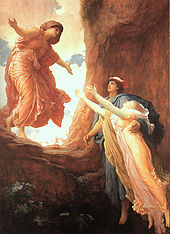 The Return of Persephone by Frederic Leighton, (1891).
The Return of Persephone by Frederic Leighton, (1891).
In Mycenaean Pylos, Demeter and Persephone were potniai (the mistresses). In classical Greece, they were invoked as tō theō ('the two Goddesses')[citation needed] or hai despoinai ('the Mistresses').[41] Myths and cults to Demeter as Mother and Persephone as Maiden (Kore) lay at the heart of the Eleusinian Mysteries.
Demeter controlled seasonal growth and regeneration. When her virgin daughter Persephone was abducted to underworld by Hades, Demeter searched for her ceaselessly, preoccupied with her loss and her grief. The seasons halted; living things ceased their growth, then began to die.[42] Faced with the extinction of all life on earth, Zeus sent his messenger Hermes to the underworld to bring Persphone back. Hades agreed to release her if she had eaten nothing while in his realm; but Persephone had eaten a number of pomegranate seeds (one, three, four, or seven seeds are eaten.. This bound her to Hades and the underworld for certain months of every year. According to some modern writers such as Walter Burkert, this corresponds with the dry Mediterranean summer, during which plant life is threatened by drought.[43] Winter, autumn, and spring by comparison have heavy rainfall and mild temperatures in which plant life flourishes. However the ancient commentary by Porphyry did not understand the myth in this way and saw Persephone's descent as connected with the autumn and winter months. It was during her trip to retrieve Persephone from the underworld that she revealed the Eleusinian Mysteries. In some versions of the myth, Persephone is tricked into eating the pomegranate seeds but chooses to eat them, moments before her return to the upper world with Hermes. seen Hades' gardeners, claimed to have witnessed her do so, at the moment that she was preparing to return with Hermes. Her return to the upper world signals the advent of spring. In another version, Hecate rescues Persephone.
According to the personal mythology of Robert Graves,[44] Persephone is not only the younger self of Demeter,[45] she is in turn also one of three guises of the Triple Goddess — Kore (the youngest, the maiden, signifying green young grain), Persephone (in the middle, the nymph, signifying the ripe grain waiting to be harvested), and Hecate (the eldest of the three, the crone, the harvested grain), which to a certain extent reduces the name and role of Demeter to that of groupname. Before Persephone was abducted by Hades, an event witnessed by the shepherd Eumolpus and the swineherd Eubuleus (they saw a girl being carried of into the earth which had violently opened up, in a black chariot, driven by an invisible driver), she was called Kore. It is when she is taken that she becomes Persephone ('she who brings destruction'). Hecate was also reported to have told Demeter that she had heard Kore scream that she was being carried off.[46]
Demeter's stay at Eleusis
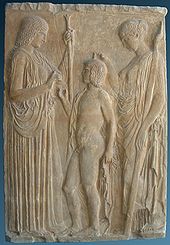 The Eleusinian trio: Persephone, Triptolemos and Demeter, on a marble bas-relief from Eleusis, 440–430 BC.
The Eleusinian trio: Persephone, Triptolemos and Demeter, on a marble bas-relief from Eleusis, 440–430 BC.
Demeter was searching for her daughter Persephone (also known as Kore). Having taken the form of an old woman called Doso, she received a hospitable welcome from Celeus, the King of Eleusis in Attica. He asked her to nurse Demophon and Triptolemus, his sons by Metanira.
As a gift to Celeus, because of his hospitality, Demeter planned to make Demophon as a god, by coating and anointing him with ambrosia, breathing gently upon him while holding him in her arms and bosom, and making him immortal by burning his mortal spirit away in the family hearth every night. She put him in the fire at night like a firebrand or ember without the knowledge of his parents.
Demeter was unable to complete the ritual because his mother Metanira walked in and saw her son in the fire and screamed in fright, which angered Demeter, who lamented that foolish mortals do not understand the concept and ritual.
Instead of making Demophon immortal, Demeter chose to teach Triptolemus the art of agriculture and, from him, the rest of Greece learned to plant and reap crops. He flew across the land on a winged chariot while Demeter and Persephone cared for him, and helped him complete his mission of educating the whole of Greece in the art of agriculture.
Later, Triptolemus taught Lyncus, King of the Scythians the arts of agriculture but he refused to teach it to his people and then tried to murder Triptolemus. Demeter turned him into a lynx.
Some scholars believe the Demophon story is based on an earlier prototypical folk tale.[47]
Consorts and children
 Features
Features- Hubris · Reciprocity · Virtue
Doctrines- Mythology · Orthopraxy · Polytheism
Practices- Amphidromia · Animal sacrifice · Iatromantis · Pharmakos · Temples · Votive Offerings
Deities- Twelve Olympians:
Aphrodite · Apollo · Ares · Artemis · Athena · Demeter · Dionysus · Hades · Hephaestus · Hera · Hermes · Hestia · Poseidon · Zeus
---
Primordial deities:
Aether · Chaos · Cronus · Erebus · Gaia · Hemera · Nyx · Tartarus · Uranus
---
Lesser gods:
Eros · Hebe · Hecate · Helios · Herakles · Iris · Nike · Pan · Selene
Texts- Argonautica · Bibliotheca · Iliad · Odyssey · Theogony · Works and Days
- Zeus
- Poseidon
- Iasion
- Karmanor
- Eubuleus
- Chrysothemis
- Triptolemus
- Amphitheus I
- Oceanus
- Dmia[48]
Portrayals
- Demeter was usually portrayed on a chariot, and frequently associated with images of the harvest, including flowers, fruit, and grain. She was also sometimes pictured with her daughter Persephone.
- The Black Demeter, a sculpture made by Onatas.
- Demeter is not generally portrayed with a consort: the exception is Iasion, the youth of Crete who lay with Demeter in a thrice-ploughed field, and was sacrificed afterwards – by a jealous, and envious Zeus with a thunderbolt, Olympian mythography adds, but the Cretan site of the myth is a sign that the Hellenes knew this was an act of the ancient Demeter.[citation needed]
See also
- 1108 Demeter, a main belt asteroid 26 km in diameter, which was discovered in 1929 by Karl Wilhelm Reinmuth at Heidelberg.
- Despoina
- Greek mythology in popular culture
- Isis and Osiris
- Poppy goddess
- Potnia
Notes
- ^ Eustathius of Thessalonica, scholia on Homer, 265.
- ^ a b Themis was an ancient Greek goddess, embodiment of divine order,law. She was the organizer of the communal affairs and she evoked the social order: Finley, The World of Odysseus, rev. ed. Viking Press. (1978:78 note 82)
- ^ John Chadwick, The Mycenean World. Cambridge University Press, 1976.
- ^ Online Etymology Dictionary "mother"
- ^ Online Etymology Dictionary "Demeter"
- ^ Adams, John Paul, Mycenean divinities List of handouts for California State University Classics 315, retrieved 7 March 2011.
- ^ Chadwick, The Mycenaean World, Cambridge University Press, 1976, p. 87) "Every Greek was aware of the maternal functions of Demeter; if her name bore the slightest resemblance to the Greek word for 'mother', it would inevitably have been deformed to emphasize that resemblance. [...] How did it escape transformation into *Gāmātēr, a name transparent to any Greek speaker?" Compare the Latin transformation Iuppiter and Diespiter vis-a-vis *Deus pāter.
- ^ Orphic Hymn 40 to Demeter (translated by Thomas Taylor: "O univeral mother Deo famed, August, the source of wealth and various names".
- ^ Martin Nilsson, Geschichte der Griechischen Religion, vol. I (Verlag C.H.Beck) pp 461-462.
- ^ Nilsson, 1967:444
- ^ Frisk, Griechisches Etymological Woerterbuch. Entry 1271
- ^ Walker, B. G. The Woman's Encycloped of Myths and Secrets, pg 218-219
- ^ Walker, B. G. The Woman's Encycloped of Myths and Secrets, pg 219
- ^ Walker, B. G. The Woman's Encycloped of Myths and Secrets, pg 413, 780
- ^ Odyssey 5.499
- ^ Hesiod Works and Days, 465
- ^ Odyssey 5.125; Theogony 969 ff.
- ^ Hesiod, Theogony 912; Homeric Hymn to Demeter (2); Pausnias, Description of Greece 8.37.9
- ^ Martin Nilsson, Greek Popular Religion. pp 48-50
- ^ Martin NIlsson (1967).Die Geschichte der Griechischen Religion.V.H.Beck Verlag.Munchen pp 479-480
- ^ Isocrates, Panegyricus4.28: "When Demeter came to our land, in her wandering after the rape of Kore, and, being moved to kindness towards our ancestors by services which may not be told save to her initiates, gave these two gifts, the greatest in the world — the fruits of the earth, which have enabled us to rise above the life of the beasts, and the holy rite, which inspires in those who partake of it sweeter hopes regarding both the end of life and all eternity".
- ^ Nilsson, Martin P. (1940). Greek Popular Religion. p. 45: "We have a document concerning the Eleusinian cult which is older and more comprehensive than anything concerning any other Greek cult, namely, the Homeric Hymn to Demeter composed in Attica before Eleusis was incorporated into the Athenian state, not later than the end of the seventh century BC. We know that the basis of the Eleusinian Mysteries was an old agrarian cult celebrated in the middle of the month Boedromion (about October) and closely akin to the Thesmophoria, a festival of the autumn sowing celebrated by the women not quite a month later. I need not dwell upon this connection, which is established by internal evidence as well as by direct information."
- ^ Graves, Robert (1960). Greek Gods and Heroes. Dell Laurel-Leaf.
- ^ L. H. Jeffery (1976). Archaic Greece: The Greek city states c.800-500 B.C (Ernest Benn Limited) p. 42 ISBN 0-510-03271-0
- ^ Pausanias 8.25.50
- ^ C.M. Bowra(1957), The Greek Experience(1957:87, 169).
- ^ Pausanias 1.22.3.
- ^ Pausanias 3.14.5
- ^ Anesidora: inscribed against her figure on a white-ground kylix in the British Museum, B.M. 1881,0528.1, from Nola, painted by the Tarquinia painter, ca 470–460 BC (British Museum on-line catalogue entry)
- ^ Pausanias.Guide to Greece.9.39.2-5
- ^ Pausanias 8.13.13
- ^ Martin Nilsson (1967).Die Geschichte der Griechiesche Religion Vol. I pp 477-478.
- ^ Herodotus, v. 61; Plutarch Isis et Osiris p. 378, d
- ^ Smith, William (1867). "Achaea (1)". In Rachel, William. Dictionary of Greek and Roman Biography and Mythology. 1. Boston. p. 8. http://www.ancientlibrary.com/smith-bio/0017.html
- ^ Pausanias, 7. 27, 9.
- ^ Cohen, A, Art in the Era of Alexander the Great: Paradigms of Manhood and Their Cultural Traditions, Cambridge University Press, 2010, p. 213. Googlebook preview
- ^ "In Arcadia she was also a second goddess in the Mysteries of her daughter, the unnameable, who was invoked only as 'Despoina', the 'Mistress'" (Karl Kerenyi, Eleusis: Archetypal Image of Mother and Daughter(Princeton University Press) 1967:31f, instancing Pausanias, viii.37.9.
- ^ L. H. Jeffery (1976). Archaic Greece: The Greek city states c.800-500 B.C (Ernest Benn Limited) p 23 ISBN 0-510-03271-0
- ^ Other ritually bathed goddesses were Argive Hera and Cybele; Aphrodite renewed her own powers bathing herself in the sea.
- ^ Kerenyi, The Gods of the Greeks, 1951:185.
- ^ Pausanias, Description of Greece 5.15.4.
- ^ Karl Kerenyi, The Gods of the Greeks, 1951, pp.232 - 41 and notes 784 - 98.
- ^ Burkert, Greek Religion (Harvard, 1985) p. 160.
- ^ Graves' work on Greek myth was often criticized; see The White Goddess#Criticism and The Greek Myths.
- ^ The idea that Kore (the maiden) is not Demeter's daughter, but Demeter's own younger self, was discussed much earlier than Graves, in Lewis Richard Farnell (1896), The Cults of the Greek States, volume 3, p.121.
- ^ Graves, Robert. The Greek Myths. Penguin, 1990. ISBN 0-14-001026-2. 24. pp.94–95.
- ^ Nilsson (1940), p. 50: "The Demophon story in Eleusis is based on an older folk-tale motif which has nothing to do with the Eleusinian Cult. It is introduced in order to let Demeter reveal herself in her divine shape".
- ^ Hesychius of Alexandria, s. v.
References
- Walter Burkert (1985) Greek Religion, Harvard University Press, 1985.
- Ingri and Edgar Parin d'Aulaire, D'Aulaire's Book of Greek Myths, 1962. An illustrated book of Greek myths retold for children.
- Jane Ellen Harrison, Prolegomena to the Study of Greek Religion, 1903
- Hesiod, Theogony, and Works and Days in The Homeric Hymns and Homerica with an English Translation by Hugh G. Evelyn-White. Cambridge, MA.,Harvard University Press; London, William Heinemann Ltd. 1914.
- Karl Kerenyi, Eleusis: archetypal image of mother and daughter, 1967.
- Karl Kerenyi, Dionysos: Archetypal Image of Indestructible Life, 1976
- Martin P. Nilsson, Greek Popular Religion, 1940. Sacred-texts.com
- Pausanias, Pausanias Description of Greece with an English Translation by W.H.S. Jones, Litt.D., and H.A. Ormerod, M.A., in 4 Volumes, Cambridge, MA, Harvard University Press; London, William Heinemann Ltd. 1918.
- Carl Ruck and Danny Staples, The World of Classical Myth, 1994.
External links
- Hymn to Demeter, Ancient Greek and English text, Interlinear Translation edited & adapted from the 1914 prose translation by Hugh G. Evelyn-White, with Greek-English glossary, notes and illustrations.
- Foley P. Helene, The Homeric hymn to Demeter: translation, commentary, and interpretive essays, Princeton Univers. Press, 1994. with Ancient Greek text and English translation.
- Text of Homeric Hymn to Demeter
- Online book of Martin P. Nilsson, Greek Popular Religion
- "The Political Cosmology of the Homeric Hymn to Demeter"
- "The Sophian Prayer to Demeter"
Greek deities series Primordial deities | Titans | Aquatic deities | Chthonic deities Twelve Olympians Aphrodite | Apollo | Ares | Artemis | Athena | Demeter
Dionysus | Hephaestus | Hera | Hermes | Hestia | Poseidon | ZeusChthonic deities Hades | Persephone | Gaia | Demeter | Hecate | Iacchus | Trophonius | Triptolemus | Erinyes Greek religion and mythology Religions and cults Groups Twelve Olympians Other major deities Heroes Rites and practices - Amphidromia
- Hymns
- Iatromantis
- Pharmakos
- Prayers
- Sacrifices
- Temples
- Votive offerings
Sacred places Categories:- Demeter
- Indo-European deities
- Agricultural goddesses
- Animal goddesses
- Eleusinian Mysteries
- Greek goddesses
- Twelve Olympians
- Greek mythology
- Primordial teachers
- Divine women of Zeus
- Chthonic
Wikimedia Foundation. 2010.


